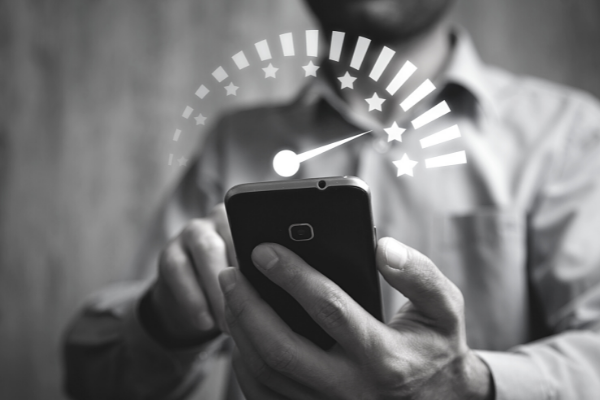Our brains love the status quo.
It's natural to continue on in familiar paths that have worked for us before.
This is very true for financial institutions—why change what’s worked in the past?
When something shakes up our normal mode of operation, we are out of our element. And, COVID really threw everyone for a loop. It’s caused a lot of uncertainty and forced entire industries to change up the approach to many things.

But, this can be a golden opportunity to grow.
It’s important not to waste the forced change by missing those things that could make us stronger in a post-COVID world.
In a recent episode of the Banking on Digital Growth podcast, James Robert Robert Lay talked with Melina Palmer, CEO of The Brainy Business about change during this time. James Robert and Melina talked about how all companies, especially banks and credit unions, really need to understand the brain in order to successfully navigate change.
Your Brain Can’t Be Trusted
On a subconscious level, your brain doesn’t usually make rational decisions. On a normal day, you might catch yourself snacking on whatever lies within reach, mindlessly eating empty carbs. Or, maybe you catch yourself grabbing a few extra items in the impulse buy section at the grocery store. Many businesses are set up because we know the brain is making choices without involving our better judgment.
We make snap-decisions on what we think about brands based on their logos. We shy away from brands that made us feel irritated in the past.
And, we buy up all the toilet paper in a pandemic.
Melina reminds us all that people often make irrational decisions in the face of high emotion:
“When we don't have control, you start to freak out a little bit. And this is where people go out and buy exorbitant amounts of toilet paper and hand sanitizer and make risky decisions and do strange things. Even when you know it's irrational, but you just can't stop yourself because you're in this place of uncertainty. And the only way you feel like you're protecting your family or doing something, is to stock up on canned goods or bottled water or whatever that happens to be.”
People need to know their place in the world.
“Unprecedented times” isn’t something people know what to do with.
There isn’t a whole lot to go on and we have no “well, it’s worked before” to subconsciously lean back on.
It really helps to realize the subconscious brain can’t be trusted.
Instead of buying massive amounts of toilet paper on impulse, we can choose to walk past that shelf that is partially empty (and crying out to us with the “LIMIT 1 DUE TO HIGH DEMAND” sign that speaks volumes to our panicked subconscious).
And, you can use this understanding to build up the community while growing as a company.
How to Change, Despite Your Brain
The vast majority of what happens in the brain is in the subconscious. If that subconscious can’t be trusted in the midst of the unknown, then you have to take charge and be very mindful of intent.

Melina and James Robert discussed a few different ways to take advantage of the opportunity to change, despite the brain working to hold you back at every point possible in an attempt to keep you on familiar paths.
1. Determine What Matters (And What Doesn’t)
There are a lot of things we hold onto for no reason. When a massive shift was made to keep employees at home, many companies found themselves in a tough place. For years, they had fought to keep workers from going remote. In some cases, security or productivity concerns were the reasons workers were kept in the traditional office setting. But, with COVID-19, companies had to consider when certain policies really mattered and where they could be changed.
Some companies did a lot better at adapting post-COVID than others. When we are out of our element, it really is the perfect time to examine rules, roles and regulations that have been put in place. It’s time to look at things in a new way and be ready to let go of anything that isn’t a necessary part of the system.
2. Plan for Change
We will never go back to what things were before COVID.
Embracing this truth is freeing. It allows us to move away from trying to examine what has changed for the worse and, instead, look forward to what will change for the better.
Rather than drag our feet into change, Melina says, we can find out ways to offer better services when change has been forced onto us.
Everything is turned upside down, giving us opportunities to improve ourselves. COVID has occurred, so the only way to move forward with courage and confidence is with that perspective in mind.
Melina pointed out how banks and credit unions have had to offer digital offerings, like electronic notaries or digitized signatures for everything.
3. Offer a Message of Help and Support
In a world of turmoil and negativity, brands have an opportunity to offer a guiding beacon of light. They can offer honest support and value that uplift their customer base. Not only do these behaviors improve the world today, they build trust with consumers for tomorrow.
Brands today can build up the subconscious goodwill of their customer base for the future.
Melina points out how Zappos was an example of a brand that went way above and beyond the normal call of duty. They offered to just listen to their potential customers and provide a human connection (not a sale).
It’s not a revolutionary idea. It’s just getting back to our human roots over our business strategy.
4. Make Change Easier
We can make this change process easier in our own day-to-day by understanding how our brains work. In order to make it easier to spot changes and move forward decisively (not frozen with fear), we can create our to-do lists in ways that support our subconscious thinking. Melina recommends we:
- Recognize cues that reward
- Limit goals to stay focused
- Focus on productivity over busywork
- Look for the positive
- Find reasons to be grateful
Keeping our mindset as positive and focused as possible will help us move towards the kind of change that leads towards lasting growth.
5. Improve Your Goal Setting
While limiting the number of goals is important for supporting the natural way our brain works, Melina and James Robert dove into goal setting a little further. To truly change for the better, shift the way you are setting goals.
Avoid thinking in the 3-5 year range typically focused on in financial services, James Robert pointed out. It isn't helpful to think that far out at this point. Instead, think ahead to 90 days out at a time, Melina suggests. Take things quarter by quarter until things even out into a new normal.
Stop creating long to-do lists and choose a singular goal for the long term (90 days) and one thing you will do each day to support that goal. If you get your one thing accomplished for the day, you can move on to other tasks. This naturally makes us feel positive about our productivity (got more than my one thing done!), instead of negative (only got three of my five things done).
Snowball on momentum by giving yourself permission to be excited about these daily victories. Rather than feel like a big flop for “failing,” Melina points out how reframing the equation gets you excited about being ahead.
Look for the positive because you will find it. Your brain likes to prove itself right. If you look for the negative, it will be there. If you look for the positives, those will be there too. The same scenario, viewed through two different lenses of positive or negative assumptions, will have a very different impact on how we perceive the situation. And, how we perceive the situation is going to impact how we act in that scenario.
Set physical reminders to help yourself stay focused. Melina explains that our brains are constantly scanning our environment and a small note or refrigerator magnet (which is what she used for her research study) can trigger reminders in the subconscious. Combine the DX (digital experience) with the HX (human experience), as James Robert put it, to support your goals.
Become the Change for Others
Melinda recalled a briefcase and backpack study that illustrated subconscious in the workplace.
In the study she referenced, two rooms were set up. One had a backpack on the table and the other had a briefcase. Both rooms were given the same collaborative assignment, but the room with the backpack was much more collaborative. Melina attributes it to how their brains perceived the room because we are constantly picking up those subconscious signals.
We need to get back to a place of collaboration and problem-solving.
Students are taught to move from backpack to briefcase throughout their education. Especially in the financial sector, you are expected to move into this ultra-professional mode of operation. The briefcase, in all its straight-edge glory, has become the goal for professional development in a subconscious way. That concept has really been turned on its head with COVID.
Now is the time to put down the metaphorical briefcase and pick up the backpack.
This article was originally published on December 14, 2020. All content © 2024 by Digital Growth Institute and may not be reproduced by any means without permission.





